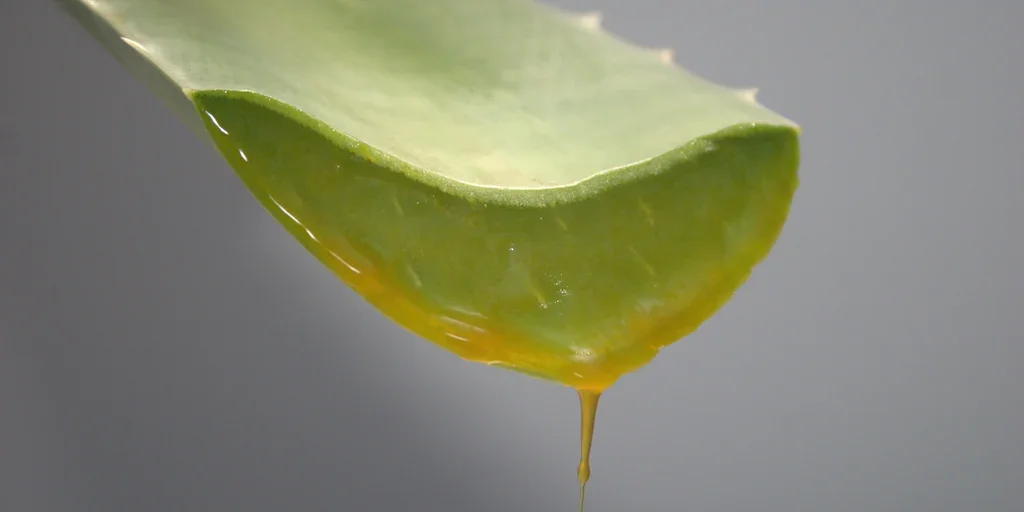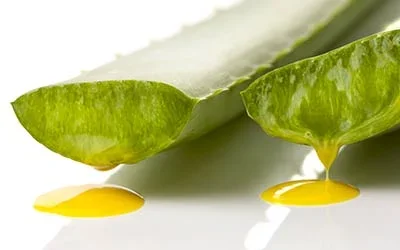Aloe Vera Outer Leaf Latex (Aloe barbadensis)
Medicinal Profile of Aloe Vera Outer
Leaf Latex (Aloe barbadensis)
Aloe vera latex is the bitter yellow sap found just beneath the rind of the leaf, distinct from the soothing inner gel. Unlike the gel, which is moistening and cooling, the latex contains anthraquinone glycosides (especially aloin) compounds that are stimulating, purgative, and strongly laxative. Aloe latex triggers peristalsis in the large intestine, causing rapid bowel evacuation by irritating the colon and drawing water into the bowel. Energetically, aloe latex is stimulating, drying, and forcefully clearing, making it appropriate only for short-term use when constipation arises from cold stagnation and lack of movement, never when tissue dryness or tension is present. Overuse can weaken bowel tone and create dependency.
Aloe latex is a medicinal purifier, not a nutritive demulcent and should be used like a pharmaceutical-strength laxative, with precision and respect.
-
👉 Tastes describe the initial impression a food or herb leaves on the tongue, and they reveal its deeper actions in the body, shaping digestion, circulation, and tissue response.
Bitter – sharp, penetrating, cold quality that stimulates bile flow and strongly activates elimination.
Acrid (secondary note) – harsh, irritating quality that provokes contraction and expulsion in the digestive tract.
The bitter–acrid taste of aloe latex explains why it is so stimulating, clearing, and purgative compared to the cooling, soothing inner gel.
-
👉Qualities describe the felt nature of a substance or practice, and how it acts in the body beyond nutrients or chemistry.
Stimulating - Increases intestinal pace and forcefully activates peristalsis. Beneficial for cold, stagnant constipation. Can worsen tension, anxiety, or rapid heart rate in excitation terrains.
Drying - Pulls water into the bowel lumen, removing moisture from tissues. May worsen dehydration, dry stools, or dryness of mucosa.
Clearing (Strong Purging) - Evacuates stool rapidly and forcefully. Helpful only for acute, cold-type constipation. Overuse weakens bowel tone.
-
Fresh Latex (Traditional Use)
The yellow sap is collected by slicing the outer leaf and draining the latex before the gel is scooped.
Allowed to dry into a resin or hardened substance for storage.
⚠️ Highly potent, variable in strength, rarely used this way in modern practice due to dosing risks.
Dried Latex Powder
Latex is dried and ground into powder, often encapsulated.
Provides more consistent dosing but still requires caution (variable aloin content).
Standardized Extracts (Capsules / Tablets)
Modern forms often standardize the aloin content (e.g., 10–30 mg per dose).
More reliable for controlled therapeutic use; safer than raw latex.
Topical Application (Rare, Harsh)
Fresh latex occasionally applied directly to warts, corns, or fungal skin patches.
Strongly irritating; not common in contemporary herbalism.
Indicated Patterns by Affinity
👉 Indicated patterns describe the functional state of the body and its organs and/or tissues, showing whether they are dry, atrophied, too damp (pressure), stagnant, lax, inflammed, sluggish, tense or underactive. The Primary Indicated Pattern is the main state where this remedy works best. Secondary Indicated Pattern(s) are the patterns that often develop over time when the primary state is left unaddressed. The primary pattern must be supported first, as this allows the secondary patterns to naturally ease or resolve.
👉Affinities are the organ systems and tissues where the remedy acts most strongly.
-
Primary Indicated Pattern: Congestive + Congestive Pressure
When fullness, bloating, or pressure builds in the lower abdomen due to trapped stool and weak peristalsis. In this terrain, constipation does not come from dryness, it comes from congestion. The bowel feels heavy or stuck, often with a sense of incomplete elimination. Examples: swollen or distended belly, difficulty passing stool even when the urge is present, puffiness in the abdomen from fluid stagnation, relief after elimination.
Aloe latex is drying, stimulating, and clearing, triggering a strong peristaltic reflex that mechanically expels stool and relieves internal pressure.
-
Digestive System
Laxative (Purgative) – stimulates peristalsis through anthraquinones (aloin, emodin), rapidly moving stool.
Cholagogue – stimulates bile flow, aiding digestion of fats and liver clearance.
Bitter Digestive Stimulant – awakens sluggish digestion by provoking secretions and motility.
Liver & Detoxification Pathways (Indirect)
Detoxifying Agent – accelerates elimination of metabolic waste and toxins via bowels.
Cleansing – supports “reset” of congested digestion by moving stagnant material.
Immune System (Indirect)
Indirect immune relief – by clearing stagnant waste, reduces burden on immune defenses.
Antimicrobial properties (mild, secondary) – anthraquinones show some activity against bacteria and fungi in vitro, though not the main therapeutic role.
Reproductive System
Uterine Stimulant (undesired effect in pregnancy) – anthraquinones increase pelvic circulation and contractions; historically noted as an abortifacient.
-
Mature vs. Young Aloe Leaves
Mature Leaves (outer, older leaves at the base) contain higher concentrations of yellow latex (anthraquinones like aloin, emodin).
→ Medicinal Strength: closer to 3rd degree (Strong purgative).
Young Leaves (inner, newly emerging leaves near the center contain much less latex, mostly clear gel.
→ Medicinal Strength: more aligned with 2nd degree (Moderate, soothing, daily supportive).
Better for gel use (burns, digestion, hydration), since the gel is purer and less likely to have irritating anthraquinones.
-
Anthraquinones (Aloin, Emodin, Aloe-emodin) – bitter compounds that stimulate bowel peristalsis, responsible for the strong laxative action.
Chromones (aloesin, aloesone) – contribute to bitterness; some have mild antioxidant and anti-inflammatory activity.
Resins – irritating compounds that amplify the purgative effect.
Polysaccharides (trace in latex compared to gel) – minor presence; most polysaccharides are in the inner gel, not the latex.
Phenolic Glycosides – contribute to bitter taste and clearing action.
-
Because aloe latex is a strong anthraquinone laxative, it interacts with other herbs that affect the bowels, fluids, or electrolyte balance:
Other Anthraquinone Laxatives
Senna (Senna alexandrina), Cascara (Frangula purshiana), Rhubarb root (Rheum officinale)
Combination may cause excessive purgation, cramping, and dehydration.
Diuretic Herbs:
Dandelion leaf, Nettle leaf, Horsetail, Corn silk
May worsen potassium depletion and electrolyte imbalance when combined.
Bitter Stimulants
Gentian, Wormwood, Goldenseal
⚠️ Can amplify digestive stimulation, sometimes tipping into nausea, cramping, or spasms.
Demulcent / Moistening Herbs (Helpful pairing)
Marshmallow root, Licorice, Slippery elm, Aloe inner gel
✅ These can soften irritation and reduce harshness of aloe latex, making it safer in sensitive individuals.
-
Pregnancy & Breastfeeding
Contraindicated. Aloe latex contains anthraquinones (aloin) that stimulate uterine contractions and can pass into breastmilk, risking colic in infants.
Children & Toddlers
Not recommended. Too harsh for developing systems; safer gentle laxatives should be used instead (e.g., prunes, flaxseed tea).
Chronic Use
Avoid long-term or frequent use. Can cause dependency, electrolyte imbalance (especially potassium loss), dehydration, and worsening hypofunction over time.
Inflammatory Gut Conditions
Contraindicated in IBS, Crohn’s disease, ulcerative colitis, or hemorrhoids. Aloe latex irritates mucosa and may worsen pain, bleeding, or spasms.
Kidney Disorders
Contraindicated. High anthraquinone load is nephrotoxic; linked to kidney irritation and failure in large doses.
Drug Interactions
Avoid with diuretics, corticosteroids, or cardiac glycosides (e.g., digoxin). Electrolyte shifts (especially potassium loss) increase drug toxicity risks.
Avoid with stimulant laxatives (senna, cascara, rhubarb). May cause excessive purgation and electrolyte depletion.
Elderly & Frail Individuals
Caution. Fragile systems are more prone to dehydration, collapse, and dependency from strong laxatives.
Topical Use Caution
Aloe latex is sometimes applied to warts or calluses but is irritating and staining (yellow-brown). Avoid use on open skin or sensitive tissue.
⚠️ Important: The suggested ranges (10–30 mg aloin equivalent) come from traditional herbal references, pharmacopoeias, and modern regulatory guidelines such as: European Medicines Agency (EMA) community herbal monograph on Aloe latex, Commission E Monographs (Germany) on anthraquinone-containing laxatives, Contemporary herbal references (e.g., American Herbal Pharmacopoeia).
👉 In practice, doses should always start low (around 10 mg aloin) because individual sensitivity varies widely. Stronger doses (20–30 mg aloin) are reserved for short-term/emergency use only.
👶 Rule of Thumb for Children
Children (7–12 years): ½ the adult dose.
Toddlers (2–6 years): ¼ the adult dose.
Infants (<2 years):Not recommended — aloe latex is too harsh for this age group.
⚠️ Important: Children’s use of aloe latex is extremely rare in modern practice due to safety concerns; the above “rule of thumb” is a traditional dosing principle for bitter/purgative herbs in general, but most modern sources recommend avoiding aloe latex altogether in pediatrics.
-
Grindlay, D., & Reynolds, T. (1986). The Aloe vera phenomenon: A review of the properties and modern uses of the leaf parenchyma. Journal of Ethnopharmacology, 16(2–3), 117–151.
Eshun, K., & He, Q. (2004). Aloe vera: A valuable ingredient for the food, pharmaceutical and cosmetic industries – A review. Critical Reviews in Food Science and Nutrition, 44(2), 91–96.
Boudreau, M. D., & Beland, F. A. (2006). An evaluation of the biological and toxicological properties of Aloe barbadensis (Miller), Aloe vera. Journal of Environmental Science and Health Part C, 24(1), 103–154.
Ulbricht, C., et al. (2008). An evidence-based systematic review of Aloe vera by the Natural Standard Research Collaboration. Journal of Herbal Pharmacotherapy, 7(3–4), 279–323.
European Medicines Agency (EMA). (2013). Community herbal monograph on Aloe barbadensis Mill. and Aloe (various species) – Latex.
Bruneton, J. (1999). Pharmacognosy, Phytochemistry, Medicinal Plants. Lavoisier Publishing.
Newall, C. A., Anderson, L. A., & Phillipson, J. D. (1996). Herbal Medicines: A Guide for Healthcare Professionals. Pharmaceutical Press.
Blumenthal, M., Goldberg, A., & Brinckmann, J. (2000). Herbal Medicine: Expanded Commission E Monographs. American Botanical Council.



